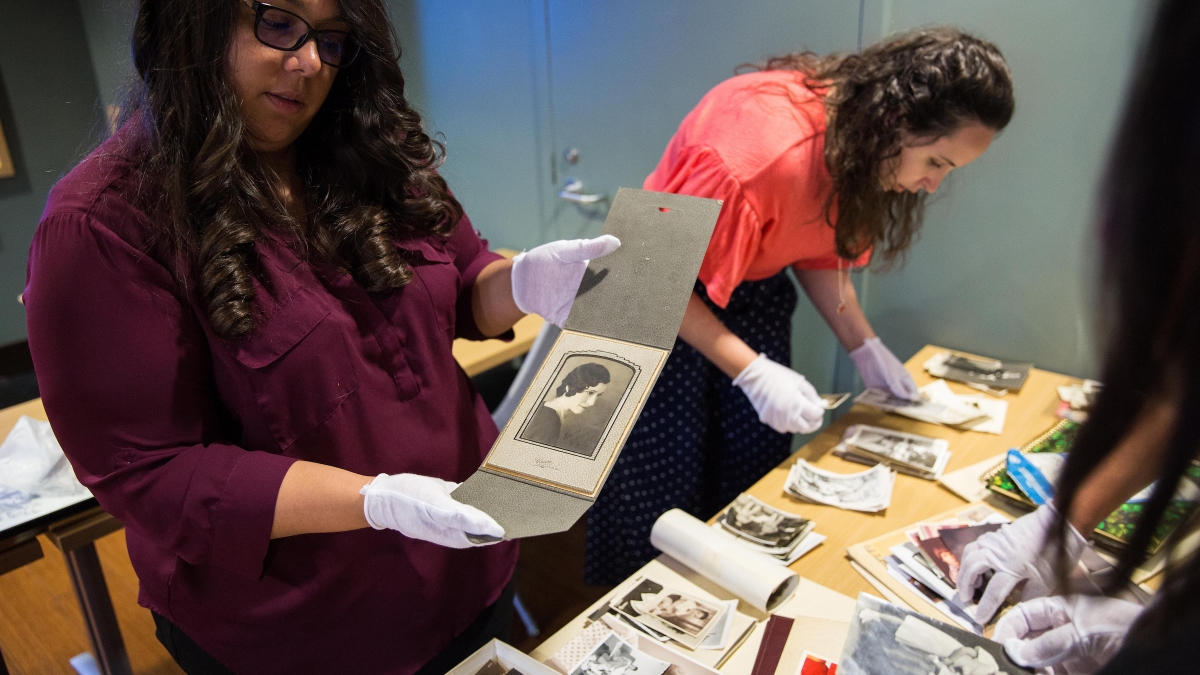How do we amend Arizona’s archives?
ASU archivists work to reduce a disparity in the representation of minority communities in archival materials

Arizona State University archivist Nancy Godoy begins her "Archival and Preservation" workshop with a startling statistic: Minority communities constitute 42 percent of Arizona's population, but their photographs and documents only make up 2 percent of materials in state archives.
The workshop, led by ASU archivists, looks at methods of organizing family archives. The series, funded by the Andrew W. Mellon Foundation, aims to teach archival methods to underrepresented communities in Arizona.
“I think the three-year grant project is meant to lay the foundation for change in the next 30 or 40 years,” Godoy said. “We want them to know how to preserve and do it themselves and if they need help or support they know who to turn to, and if people do want to donate material that’s going to help us fix that gap within the archives.”
ASU alumnus Carlos Dominguez came to the workshop with a large plastic bin overflowing with photographs and materials spanning 100 years of his family’s history. Godoy was excited.
“It gave me an archive glow,” she said.
Godoy and archive specialist Alana Varner suggested that Dominguez begin organizing by time period since many photographs have no notes. They offered clues to help sort: A red-tinted color image is likely from the '70s, and a short tie on a man was popular in the '40s.
Godoy held up a photograph of a couple with a young boy, impeccably dressed, at what appears to be a festival. In the background a couple of young women, in tight jeans, lean against a booth.
“Look at her glasses,” said Godoy, pointing out the stylish horn-rims. “I’d say early '60s, if not late '50s, and look at the pants they’re wearing in the back too.”
They admired a baby shower invitation for someone who would be nearly 90 today, and a group photo of his grandfather, the first Latino lineman for SRP. Dominguez’s own elementary school portrait, complete with neon splatter backdrop, is mixed in with the photographs of the previous three generations.
The task may seem daunting, but for Dominguez it’s a matter of taking the occasional weekend or evening to sort it out.
“Families are like living things, so it’s always a work in progress no matter what,” he said.
For participant Lisa Chow, a visit to her father’s old store in Cleveland, Mississippi, and a fortunate discovery led her to learn more.
Amongst pots and pans and old clothes meant for a rummage sale, her husband discovered a box of items from her late uncle’s World War II service, including purple hearts and letters of thanks from President Harry Truman.
“It was a fluke that we found them,” she said. “He found this huge box that had even some old black-and-white photos from the 1920s that were my uncles and were all going to get tossed or donated.”
At the end of the workshop, Godoy sent participants home with the tools they’ll need: an acid-free box, folders, Mylar sleeves for photographs and materials, and cotton gloves, but first she reminded them that the important thing is to save what’s important for their own family histories.
6 tips for archiving your photographs
1. Ziploc bags for photographs and plastic bins are a good starting point if you’re on a budget.
2. Michaels sells acid-free photo albums that are a better alternative as most scrapbooks and albums will deteriorate photos.
3. VHS and other magnetic tapes need to be scanned as soon as possible. They detoriate faster than Super 8 or 35mm reels.
4. Family photos will deteriorate over time. Scan photographs, make a new print and store the original images in Mylar sleeves or on acid-free paper in acid-free folders to preserve them for the future.
5. Use cotton gloves and pencils instead of bare hands and pens. Fingers have oils, and most inks will deteriorate documents over time.
6. Ask family members to look at photographs with you and write down what they say. Videotaping this is a good idea too to capture the stories they’ll share.
Future events
Scanning and Oral History Day
Learn how to scan archival material. ASU staff will scan up to 50 free scans per person. Using StoryCenter listening stations, people will also learn how to conduct an oral history interview and have the option to record their own stories.
• 10 a.m.–2 p.m. Friday, April 27, Alston House, 453 N. Pima St., Mesa. Details are available on the Facebook event page.
• 10 a.m.–2 p.m. Saturday, May 19, 9405 S. Avenida del Yaqui, Guadalupe. Details: Facebook event page.
Archives and Preservation Workshop
• 6–8 p.m. Wednesday, April 25, AE England Building, Downtown Phoenix campus, 424 N. Central Ave. Details: Facebook event page.
• 10 a.m.–noon. Saturday, May 12, Harmon Library, 1325 S. Fifth Ave., Phoenix. Details: Facebook event page.
Top photo: Archivist Nancy Godoy helps ASU alumnus Carlos Dominguez organize his photographs and archival materials during the "Archives and Preservation" workshop at the Tempe Public Library on April 15. ASU Library staff taught individuals how to appraise, arrange and describe archival materials in order to preserve them for future generations. Photo by Deanna Dent/ASU Now